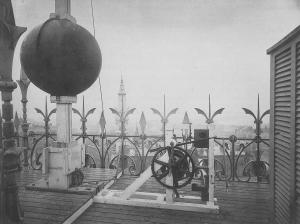Time Balls [1]
Observatories of the 19th century didn’t receive government funding. They relied mainly on private donors, although they sometimes had to get creative to pay the bills. The Cincinnati Observatory, for example, sold time — for a thousand dollars a year.
The observatory was one of many that operated a time ball. The ball was placed on a pole atop the dome. The ball was dropped at precisely noon — allowing businesses and individuals to synchronize their clocks.
Observatories provided the service because they had special instruments that allowed them to calculate the precise time of local noon — the moment the Sun was highest in the sky. That made them perfect timekeepers.
Time balls were first used in England. Ship’s navigators needed to know the time to plot their longitude — their east-west position on the globe. To do that, though, they had to have a reference point — a point where they knew the exact longitude and the correct time.
So a young officer in the royal navy suggested a time ball. The ball would be dropped from a high point at a specific time. Navigators aboard ship could observe the drop by telescope, and use the time to set their chronometers.
The first time ball was in Portsmouth, in 1829. An additional time ball was set up atop the Royal Observatory at Greenwich in 1833. The ball was dropped at precisely 1 p.m. And it still operates today — keeping time for all to see.
More about time balls tomorrow.
Script by Damond Benningfield


